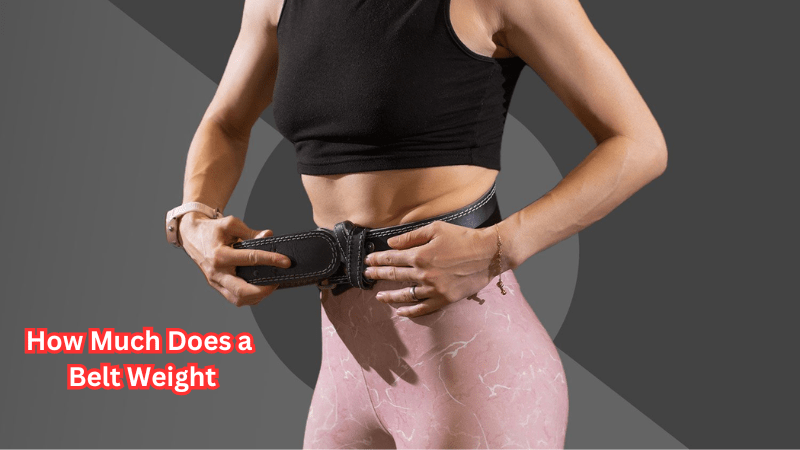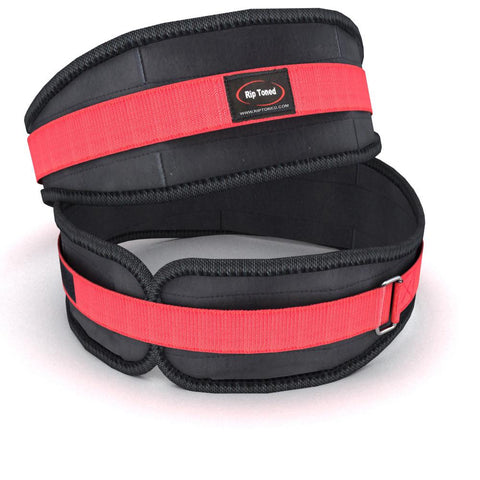
How Much Does a Belt Weight
Share
In the world of fashion and functionality, the weight of a belt often goes unnoticed but plays a crucial role. Knowing how much a belt weighs can influence comfort, style choices, and performance in specific activities.
Whether it's a sleek leather belt for a business meeting, a durable fabric belt for outdoor adventures, or a sturdy lifting belt for the gym, each type has its weight characteristics.
This guide delves into the various factors that affect belt weight, from materials to design, and why understanding this aspect can help you make informed decisions when choosing the perfect belt for any occasion.
What is a Weightlifting Belt and How Does it Work?
A weight belt is a supportive gear worn around the waist to provide stability and reduce stress on the lower back during heavy lifting exercises. It is commonly used by powerlifters, bodybuilders, and other athletes in strength training.
Weightlifting belts are usually made from thick leather or synthetic materials and weigh anywhere between 0.5 to 2 pounds. The added weight of the belt may seem insignificant, but it serves an essential purpose in helping lift heavier weights safely.
The design of a weight lifting belt works by increasing intra-abdominal pressure, which creates a more rigid core and supports the spine during lifts. This pressure also helps to stabilize the torso, leading to improved balance and technique reducing the risk of injury.
Types of Weightlifting Belts
There are various types of belts available, each with its unique characteristics and weight. Here are the most common types:
- Powerlifting Belts: These are typically 4 inches wide and made from thick, stiff leather to provide maximum support while lifting heavy weights. They can weigh between 1.5 to 2 pounds. Leather lifting belts are also known for their durability and long lifespan. Lever belt options are also available, which can reduce the belt's weight by half a pound.
- Olympic Weight Lifting Belts: These are narrower at around 2-3 inches and made from softer materials like suede or leather. They allow for more flexibility in movement and can weigh around 0.5 to 1 pound. Olympic or overhead lifts require more mobility, and these belts provide the right support without hindering performance.
- Velcro Belts: These are lightweight and easy-to-use belts that use a velcro strap instead of a buckle for closure. They come in various widths depending on the level of support needed and can range from 0.5 to 1 pound in weight.
- Nylon Lifting Belts: These are popular among CrossFit athletes and are made from heavy-duty nylon material that provides support without limiting movement. They can weigh between 0.5 to 1 pound.
Other Types of Belts
Apart from weightlifting belts, there are other types of belts that serve different purposes and have varying weights.
- Fashion Belts: These are the most common type of belts worn as a fashion accessory and come in a variety of materials such as leather, fabric, or metal. Fashion belts can weigh anywhere between 0.2 to 1 pound, depending on the design.
- Outdoor Adventure Belts: These are designed for outdoor activities like hiking, camping, or climbing and are made from durable fabrics like nylon. They usually have added features like quick-release buckles or hidden pockets and can weigh between 0.5 to 1 pound.
- Weight Loss Belts: These belts are marketed to lose belly fat by increasing sweat in the abdominal area during workouts. They can weigh between 0.5 to 1 pound and are usually made from neoprene.
Factors That Affect Belt Weight
Now that we have explored the different types of weightlifting belts, let's look at the various factors that can affect their overall weight:
1. Materials
The type of material used in a belt is the primary determinant of its weight. Leather belts, which are the most common, can range from lightweight to heavy depending on the type of leather and its thickness. For example, a thin dress belt made with calfskin leather weigh significantly less than a thick work belt made with top-grain cowhide leather.
On the other hand, fabric belts like canvas or nylon tend to be much lighter than their leather counterparts due to the nature of the material. These belts are often popular among outdoor enthusiasts who value functionality and comfort over style.
2. Buckle Type
Another factor that contributes to a belt's weight is the type of buckle used. Traditional belts with metal buckles tend to be heavier than those with plastic or velcro fasteners. This weight difference may not seem significant, but for some athletes who need to minimize any additional load, it can make a difference.
3. Width and Thickness
The width and thickness of a belt also affect its overall weight. Wider and thicker belts, such as powerlifting or bodybuilding belts, will naturally weigh more due to the increased material used in their construction.
In contrast, thinner and narrower belts like Olympic lifting belts or fabric belts will weigh less due to their minimalist design. Lever weightlifting belt options are also available, which can reduce the overall weight by eliminating the need for a buckle.
4. Additional Features
Some belts may come with additional features like padding, extra layers for added support, or a built-in phone pocket. These added elements can contribute to the overall weight of the belt and should be considered when choosing a belt for specific activities.
To lift performance and prevent injury, it is essential to choose a weightlifting belt that fits your needs and body type. Understanding the various factors that affect a belt's weight can help you make an informed decision when selecting the perfect belt.
How Much Does a Belt Weight?
The weight of a belt can vary greatly depending on its type and design. Generally, leather belts used for powerlifting and bodybuilding tend to be the heaviest, weighing between 1.5 and 2 pounds. On the other hand, lighter materials like nylon or fabric result in more lightweight belts that can range from 0.5 to 1 pound.
For athletes concerned about any additional weight affecting their performance, there are also options for minimalist belts with velcro closures or thinner widths that weigh even less.
It's important to keep in mind that while the weight of a belt may seem insignificant compared to the weights being lifted during workouts, it serves an essential purpose in providing support and stability to the core and spine.
Choosing the right belt with the appropriate weight for your needs is crucial in ensuring safe and effective strength training. One weightlifting belt FAQ is if it's necessary to wear a weightlifting belt at all times during training. The answer is no, as wearing one constantly can hinder the development of core strength and may even lead to dependency on the belt.
Average Weights of Common Belts
Now, let's take a look at the average weights of some common belt types:
- Leather Belts: This category includes powerlifting belts, bodybuilding belts, and traditional dress belts. On average, leather belts weigh between 1 to 2 pounds. Weightlifting lever belt options may be slightly lighter due to the absence of a buckle.
- Fabric Belts: These include Olympic lifting belts and outdoor adventure belts. Fabric belts usually range from 0.5 to 1 pound in weight.
- Velcro Belts: These are the lightest type of weightlifting belt, with an average weight of around 0.5 pounds.
- Nylon Belts: Similar to fabric belts, nylon belts have an average weight of 0.5 to 1 pound. A nylon lifting belt with a lever buckle may weigh slightly less.
Why Belt Weight Matters
When it comes to weightlifting, every pound matters. Athletes are constantly looking for ways to optimize their performance and minimize any additional load that may hinder their progress. While the weight of a belt may seem insignificant compared to the weights being lifted during workouts, it can still have an impact on overall performance.
For example, in powerlifting competitions where athletes are expected to lift maximum loads, even a small difference in weight between belts can potentially affect the outcome of the competition. Similarly, for CrossFit athletes who need to perform various movements quickly and efficiently, choosing a lightweight belt can make a difference in their overall speed and agility.
Furthermore, for individuals with injuries or weaker core stability, wearing a heavier belt could potentially lead to strain or injury.
How to Measure Belt Weight
If you're curious about the weight of your belt, there are a few ways to measure it. One way is to use a kitchen or any other weighing scale that can accurately measure small increments.
Another option is to compare the weight of your belt with another object that has a known weight, such as a can of soup or a gallon of milk. This method may not provide an exact measurement but can give you an idea of how heavy your belt is relative to other objects. Moreover, you can also check the manufacturer's website or product information for the average weight of their belts.
Tips for Choosing the Right Belt Weight
- Consider your sport or activity: For powerlifting and bodybuilding, a heavier belt may provide more support and stability. In contrast, for sports that require quick movements like Crossfit or Olympic lifting, a lighter and more minimalist belt may be more suitable.
- Take into account your body type: A heavier weightlifting belt may not be ideal for individuals with weaker core stability or previous injuries. In these cases, opting for a lighter belt could help prevent strain or discomfort.
- Don't sacrifice quality for weight: While choosing a lightweight belt can be beneficial in some cases, it's essential to prioritize the quality and durability of the belt.
These are just general guidelines, and it's always best to consult with a fitness professional or try on different belts to find the right weight for your specific needs.
FAQs
What weight should I get a belt?
The weight of a belt should be chosen based on your individual needs and preferences. Factors to consider include the sport or activity you're participating in, your body type and any previous injuries.
Is it better to have a lighter or heavier lifting belt?
This depends on your goals and the type of training you do. A heavier belt can provide more support and stability, but a lighter one may allow quicker movements.
Does the width of a belt affect its weight?
Yes, typically, wider belts tend to weigh more than thinner ones due to the additional material used in their construction. However, this may not always be the case, and the materials used can vary between different brands.
Conclusion
Understanding the weight of a belt is essential for making informed choices, whether for fashion, functionality, or performance. This guide has explored the different types of belts, the factors influencing their weight, and the average weights of common varieties.
By considering material, design, and intended use, you can select a belt that enhances comfort and suits your needs. Ultimately, being aware of belt weight helps ensure you choose the perfect accessory for any occasion, blending style with practicality seamlessly.

